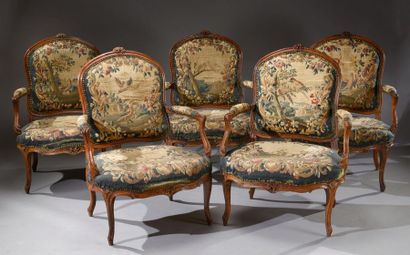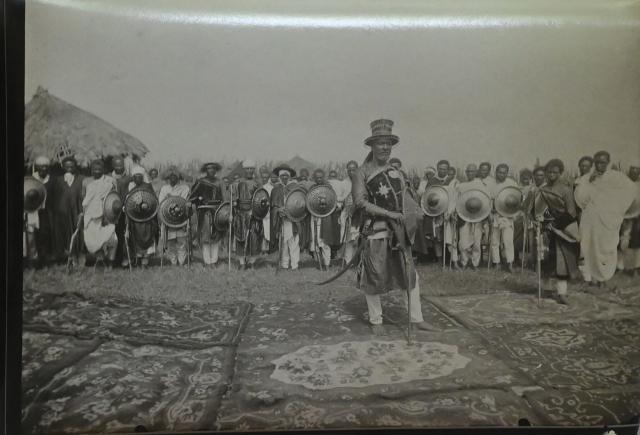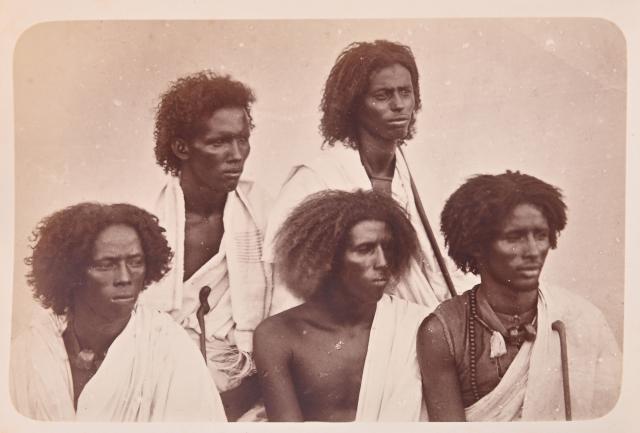Ensemble très rare et complet de douze statuettes représentant les douze généraux célestes ( jûni shinshô , également appelés jûni yaku sha taishô). Ce groupe de douze divinités Bouddhistes protectrices communément appelé Yasha accompagne le Bouddha de la médecine Yakushi et en représente la manifestation. C’est en Chine qu’à partir de la dynastie Sui les douze personnages ont été associés avec les douze animaux emblématiques (les douze branches ou signes du zodiaque). Le moine Saichô (767-822) explique, après avoir visité le pays que les douze généraux célestes ont juridiction sur les douze heures (et douze mois). Ils gouvernent également les douze points du compas. C’est à partir de la période Kamakura que les représentations du groupe sont devenues communes au Japon. Chaque figurine en bois noir figure des yeux incrustés ainsi que des armes caractéristiques en dorure ou/et des attributs. Chacune repose sur un piédestal recouvert sur trois des faces de morceaux de branches et de traces vertes (imitant un rocher), lui-même reposant sur un socle. Chacune des figurines arbore sur sa tête l’animal qu’elle représente. Le caractère chinois correspondant au signe du zodiaque figure également sur l’intérieur de chaque piédestal. Chaque figurine se trouve debout devant un halo composé de trois flammes. Les douze généraux, leur animal du zodiaque et objet correspondants sont les suivants: de gauche à droite Bikarra (le rat), Shōtora (le bœuf), Shindarra (le tigre), Makora (le lièvre), Haera (le dragon), Indara (le serpent), Santeira (le cheval), Anira (la chèvre ou le bélier), Anteira (le singe), Meishira (le coq), Bazara (le chien) and Kubira (le sanglier). Plusieurs des socles arborent une inscription donnant le nom du temple au centre de Nagoya dont le groupe est originaire, le nom des sculpteurs (Inoue Jûbei et Inoue Matabei) ainsi que la date : « un jour auspicieux du sixième mois lunaire de l’année An’ei 6 (1777) ». Période Edo. Taille totale pour chaque statuette : H. env. 65 cm; Socle: env. 35,5 x 26 cm. Very rare and complete set of the Twelve Devine Generals (jūni shinshō, also: jūni yakusha taishō) , a group of twelve Buddhist protective deities known as Yasha who accompany the Medicine Buddha Yakushi of whom they are emanations. The monk Saichō (767-822) who visited China where from the Sui Dynasty onwards the group was associated with the twelve emblematic animals (also known as the Twelve Branches or Zodiacal Signs), states that the Twelve Devine Generals have jurisdiction over the twelve hours (and twelve months). They also govern the twelve points of the compass. From the Kamakura Period representations of the group of twelve were common in Japan. Each black wooden figure with inlayed eyes stands with his gilded characteristic weapon and or attribute on a pedestal that is covered at three sides with pieces of branches that show traces of green (as imitation of rock) and which is placed on a plinth. On their head the figures show the animals of the zodiac and at the inside of the pedestal is written the character of their zodiacal sign. They all stand in front of a halo with three flames. The generals with their animal of the zodiac and their implements are: from left to right Bikarra (rat), Shōtora (ox), Shindarra (tiger), Makora (hare), Haera (dragon), Indara (snake), Santeira (horse), Anira (sheep or goat), Anteira (monkey), Meishira (cock), Bazara (dog) and Kubira (boar). Some of the plinths have an inscription giving the name of the temple in central Nagoya where the group came from; the names of their carvers: Inoue Jūbei and Inoue Matabei as well as the date: ‘an auspicious day in the sixth moon-month of the year An’ei 6 (1777)’. Edo Period. Total size for each statue : approx. : H. : 65 cm; plinth: 35,5 x 26 cm.
Ensemble très rare et complet de douze statuettes représentant les douze généraux célestes ( jûni shinshô , également appelés jûni yaku sha taishô). Ce groupe de douze divinités Bouddhistes protectrices communément appelé Yasha accompagne le Bouddha de la médecine Yakushi et en représente la manifestation. C’est en Chine qu’à partir de la dynastie Sui les douze personnages ont été associés avec les douze animaux emblématiques (les douze branches ou signes du zodiaque). Le moine Saichô (767-822) explique, après avoir visité le pays que les douze généraux célestes ont juridiction sur les douze heures (et douze mois). Ils gouvernent également les douze points du compas. C’est à partir de la période Kamakura que les représentations du groupe sont devenues communes au Japon. Chaque figurine en bois noir figure des yeux incrustés ainsi que des armes caractéristiques en dorure ou/et des attributs. Chacune repose sur un piédestal recouvert sur trois des faces de morceaux de branches et de traces vertes (imitant un rocher), lui-même reposant sur un socle. Chacune des figurines arbore sur sa tête l’animal qu’elle représente. Le caractère chinois correspondant au signe du zodiaque figure également sur l’intérieur de chaque piédestal. Chaque figurine se trouve debout devant un halo composé de trois flammes. Les douze généraux, leur animal du zodiaque et objet correspondants sont les suivants: de gauche à droite Bikarra (le rat), Shōtora (le bœuf), Shindarra (le tigre), Makora (le lièvre), Haera (le dragon), Indara (le serpent), Santeira (le cheval), Anira (la chèvre ou le bélier), Anteira (le singe), Meishira (le coq), Bazara (le chien) and Kubira (le sanglier). Plusieurs des socles arborent une inscription donnant le nom du temple au centre de Nagoya dont le groupe est originaire, le nom des sculpteurs (Inoue Jûbei et Inoue Matabei) ainsi que la date : « un jour auspicieux du sixième mois lunaire de l’année An’ei 6 (1777) ». Période Edo. Taille totale pour chaque statuette : H. env. 65 cm; Socle: env. 35,5 x 26 cm. Very rare and complete set of the Twelve Devine Generals (jūni shinshō, also: jūni yakusha taishō) , a group of twelve Buddhist protective deities known as Yasha who accompany the Medicine Buddha Yakushi of whom they are emanations. The monk Saichō (767-822) who visited China where from the Sui Dynasty onwards the group was associated with the twelve emblematic animals (also known as the Twelve Branches or Zodiacal Signs), states that the Twelve Devine Generals have jurisdiction over the twelve hours (and twelve months). They also govern the twelve points of the compass. From the Kamakura Period representations of the group of twelve were common in Japan. Each black wooden figure with inlayed eyes stands with his gilded characteristic weapon and or attribute on a pedestal that is covered at three sides with pieces of branches that show traces of green (as imitation of rock) and which is placed on a plinth. On their head the figures show the animals of the zodiac and at the inside of the pedestal is written the character of their zodiacal sign. They all stand in front of a halo with three flames. The generals with their animal of the zodiac and their implements are: from left to right Bikarra (rat), Shōtora (ox), Shindarra (tiger), Makora (hare), Haera (dragon), Indara (snake), Santeira (horse), Anira (sheep or goat), Anteira (monkey), Meishira (cock), Bazara (dog) and Kubira (boar). Some of the plinths have an inscription giving the name of the temple in central Nagoya where the group came from; the names of their carvers: Inoue Jūbei and Inoue Matabei as well as the date: ‘an auspicious day in the sixth moon-month of the year An’ei 6 (1777)’. Edo Period. Total size for each statue : approx. : H. : 65 cm; plinth: 35,5 x 26 cm.















Testen Sie LotSearch und seine Premium-Features 7 Tage - ohne Kosten!
Lassen Sie sich automatisch über neue Objekte in kommenden Auktionen benachrichtigen.
Suchauftrag anlegen